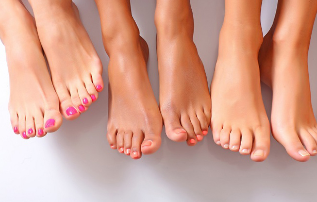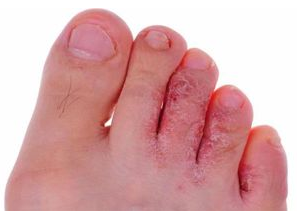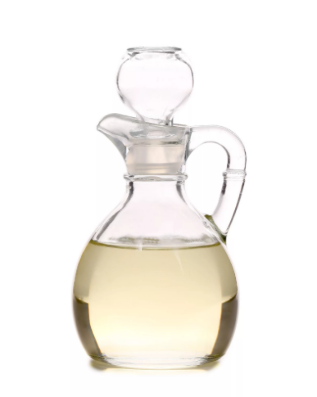Sponge – this is the common name of a group of infectious fungal diseases, which develop on the skin (thrush) and/or the nails (onychomycosis).
There are many species of fungi, parasitic on the human body. Cause a variety of unpleasant symptoms, and embitter the life of man. The most common are infection of the fungi of the genus Candida.

Causes of fungal infections
The reason for nail fungus – attack by micro-organisms. Penetration of the microorganism into the human body is going through pre-damaged nails or skin.
Reasons for such damage can become:
- The mechanical injury.
- Influence of aggressive chemical factors (corrosive detergents, etc.).
- Wearing clothes and shoes of poor quality synthetic materials, non-absorbent of moisture, and that will drop not air.
- Increased sweating, providing an optimal environment for the growth and reproduction of pathogenic microorganisms.
- The deformation of the legs, causing the deterioration of ventilation, which leads to infection mycosis.
- The high rate of growth of the nail, which can injure the skin.
- The low level of personal hygiene.
- Reduction of the protective properties of the immune system.
- Varicose disease.
- Features of the climatic conditions (high humidity).
- Older age. In elderly persons this disease occurs much the thickets.
- Professional sarcasm.
- Related pathology.
Intake of antibiotics, corticosteroids, and cytostatics, which distorts the natural microflora of humans, which protects the human skin from the entry of infection.
Special danger represent the wooden floors and benches. Mold spores penetrate into the structure of the wood and start to multiply. Derive stuck on the wooden surface of the sponge is very hard. That requires regular processing special disinfectant solutions.
Symptoms
The symptoms of athlete's foot can vary, depending on the shape, but the common are itching and pathological deformation of the skin.
Symptoms of squamous forms of fungal infections

Through education of the stratum corneum occurs the seal of the dermis. This form also bears the name "athlete's foot" and "lignum fungus", because due to the deformation of the epithelium occurs a thickening of the foot.
In this form of mold the foot a person most often experiences the following symptoms:
- Part of the heel (sole) is covered with a thick layer of the dermis, it creates the appearance of wearing on the foot moccasin.
- The horny part becomes rough and covered with a thick layer of nasty, which are starting to crack and pain.
- Rough skin begins to peel. The affected skin look as if sprinkled with flour.
- Sick of constantly experiencing unbearable, meddlesome itching.
- Occurs thinning of the nail plate, in which the nails begin to crumble and crumble.
Symptoms of dyshydrotic forms
Like the skin of the feet is quite cool, for the first time, these bubbles are not visible, other manifestations of the disease at this stage is not observed.
You can discern the appearance of small bubbles in places with softer skin (between the fingers on the feet or on the hands).
Later the bubbles start to itch, the patient is experiencing severe bothersome itching. At some point the bubbles burst, the skin begins to peel, from the surface of the epidermis becomes the peeling of the thin plates of the Horny layer of the skin.
Symptoms intertriginosny forms
Intertriginous form of the mold (or interdigital) is one of the most common and unpleasant types of pathology. The infection affects the interdigital zone.
The fold of skin between the fingers of the affected crack or ulcer, which is surrounded by flaking nekrotizirovannah skin a greenish color.
When peeling becomes mukovidnoe, the fingers look as if sprinkled with flour.
Itching is there, but it's easily docked, it's not unbearable and does not cause discomfort. While more rare, exudative form of the skin is covered with bubbles, which contain the liquid inside.
Symptoms of onychomycosis
Onychomycosis – a fungal pathology of the horny part of the dermis (the nail plate). Immediately after getting on the skin the fungus begins to actively proliferate, hitting the skin and causes unbearable itching.
The person is trying to get rid of him, he begins combing the affected area, due to the skin injured, covered with small cracks and scratches, moreover, would risk infection, bacterial or viral infections.

Hypertrophic onychomycosis
In hypertrophic onychomycosis will be a nail plate develop a yellowish begins to actively deform. This is evident by how it changes color, loses its luster, the plot thickens and partially destroyed. It brings a man great trouble, especially if it has to go in tight or uncomfortable shoes.
Normal onychomycosis
In such a onychomycosis will be a nail plate develop a yellowish does not warp and does not change its shape and structure. Occurs only change the color of the nail from normal to yellow-brown. Is to maintain the normal luster of the nail.
Atrophic onychomycosis
In this case, the color of the nail turns to brown, the nails thinner and gradually separated from the bed of the nail plate.
Diagnosis of the disease
In most cases, the fungus can diagnose yourself by symptoms. The doctor can make a diagnosis after examination of the skin and nails, and also after the collection of medical history.
Also a doctor may take a sample of skin or nail, cut his using a knife. Special tests help you determine the type of mold, and also pick up medicines and to assess the effectiveness of the treatment. In some situations it may be necessary to biopsy the skin.
Therapy of mycosis on the feet
Below we look at the most popular means and ways of how to treat mold.
Therapy of mycosis of the nails
When the disease is in the initial stage, then it is rationally to apply only external products, for example, antimycotic varnishes, solutions, ointments and gels. There is a wide choice of different drugs.
The treatment can be carried out using a special serum. There are patches, the main effect of which is aimed at the separation of the damaged nail plate.
Therapy mycosis between the toes
It is better to use a comprehensive treatment, for use as external resources, and products for home use.
If the fungus is not time spread over the entire surface of the foot, then can be offset only by external means.
In most cases, a specialist called a local remedy (the ointment), containing the fungicidal and fungistatic components.

Therapy of fungal infection in domestic conditions, how to quickly cure a
Below we look at the most popular and effective ways and means for the therapy of mycosis in domestic conditions.
Soda
In order to overcome the fungus toenails at home you is people's vehicle, how soda paste.
To prepare it, just need a little bit of baking soda, lemon juice and water. Take required for the processing of all affected areas amount of soda.
Insert it into the glass dishes. Slowly add a small amount of room temperature water, necessary for the formation of a homogeneous suspension.
After obtaining a homogeneous mass, apply it on the affected areas. After the weight will be evenly distributed on the nail plate, drip on her a small amount of lemon juice.
Due to this chemical reaction, during which you will feel a slight burning sensation. Wait 5 minutes and rinse with a plentiful quantity of warm water and thoroughly dry your feet with a clean cloth. Repeat this procedure is necessary every two days until then, until it is completely will grow healthy will be the nail plate develop a yellowish.
Therapy hydrogen peroxide
To treat fungus can help compresses with the use of hydrogen peroxide. For their manufacturing only need hydrogen peroxide and cotton wool or a cotton swab. For this, a cotton swab impregnated with a solution of hydrogen peroxide and applied on the affected nails.
Compress fix the polyethylene, thus creating the greenhouse effect. Compress on the hands holding to 20 minutes, on foot compress hold for about an hour. The course of treatment lasts two weeks and is dependent on how developed the disease.
Overlay cladding is to be repeated 2 times a day. After removal of the poultice is necessary to thoroughly rinse the nails with warm water, dry and process the cream a medicinal remedy.
Therapy iodine
To treat mold in iodine it is necessary to buy in a pharmacy common 5% alcohol solution of iodine.
Moisten the iodine quilted wand or cotton swab and apply exactly on the damaged area 2 times a day – morning and evening.
Try to get to the healthy areas of the skin. In such a case, it is a healthy skin will be damaged, changing the color to brownish-yellow and is covered with cracks.
This tool cannot be used in the presence of hypersensitivity to Yoda.

Vinegar
The most effective folk remedy for the treatment of stroke is considered to be an ordinary apple cider or vinegar, you can also use a concentrate. For the manufacture of tiles using a mixture of 9% acetic acid solution and warm water. To 1 part of vinegar charged 8 parts water.
2 tablespoon 70% vinegar essence in the mixture with 2 tablespoons of vodka and three egg whites, high protein (instead of eggs you can take glycerin). All these ingredients mix to a homogenous state and is applied to the damaged area, and do it twice a day. Store in the refrigerator no more than 3 days.
You can mix apple cider vinegar with any vegetable oil (sea buckthorn, olive, sunflower, peach) in the ratio of one to one.
The use of these products as well. For the wetted cotton or gauze swab. Tampon to impose on the affected area.
Compress moisten the drug mixture by drying. Hold it should be from half an hour to an hour, after which a poultice of peeled, washed feet abundantly with warm water, dried.
Repeat the procedure, is needed, at least, 1 once a day for two weeks.
Be careful in the treatment of compresses of vinegar. Upon the occurrence of the first signs of allergy or skin damage, it is necessary to immediately stop treatment and seek to contact a doctor.
Celandine
To treat mold and mildew are actively applying the oil of celandine. Carry out the procedure is recommended 1 times a day before going to bed. Before using preparing soda bath (1 tablespoon of baking soda to 3 liters of water) and steam in her fingers on the legs or hands, affected by a fungus.
Then his fingers carefully, to wipe away the clean towels. On the affected areas using a cotton sticks or cotton swab applying oil of celandine.
For successful treatment it is necessary to perform the procedure regularly, until the complete recovery.
During the treatment will be the nail plate develop a yellowish colour changes to orange. However, the celandine is able to cause fairly severe allergic reaction, therefore it is necessary to use caution.
Ointment for medicinal herbs
With the treatment of mold copes, ointments from medicinal herbs. To do this we need to grind the weed thyme to a powder. On 1 piece of powder charge 4 parts of vaseline. During treatment, it is possible to apply in garlic, to ensure comprehensive treatment.
Ointment of honey and eucalyptus
For the preparation of this ointment it is necessary to take 15 g of liquid honey, 15 g of soft butter and 1.5 teaspoons of vinegar. This mixture is stirred until a homogeneous state and add 25 drops of essential oil of eucalyptus or tea tree.
Stir the mixture once again until smooth and keep in the refrigerator for three days. The prepared composition is to be applied on the affected area once a day.

Prevention
- It is necessary first of all to monitor the hygiene of the skin areas that are at risk of destruction fungal infections (skin, brushes, hands, feet, nail plates). Thoroughly rinse the skin of the feet and hands with soap daily, after washing, thoroughly wipe the skin. Especially in the folds.
- Wear socks and shoes from natural materials (cotton, linen). These materials provide the proper ventilation and well to absorb excess moisture. A day change your socks clean, because a day in them can accumulate pathogenic microflora.
- Shoes should be of the breathing and blood circulation of materials. It should not squeeze, rub against or cause any inconvenience. The summer time will suit the maximum open shoes with perforation.
- Periodically treat the inner part of the shoe, especially that which can not be wash, special antibacterial means. Leave the shoes to dry after processing.
- Spend washing underwear at 60 °C. For the greatest antimicotic and antibacterial effect linen should be ironed with the iron.
- Use the individual rubber boots easily processed materials while visiting public showers, saunas, baths and swimming pools.
- Do not wear someone else's shoes, towels and bathrobes. Do not use foreign means of personal hygiene.
- Do not run the sponge. It is necessary to start the treatment already at the occurrence of the first symptoms. The sooner treatment begins, the easier it will be possible to cure.
- Carefully follow the designated doctor scheme treatment. In case, if you stop the treatment before completely cure the fungus, it is possible occurrence of relapse.
Conclusion
Nail fungus – is a complex and common disease, which is very easily become infected. So it didn't happen, follow the rules of prevention. However, if you have already signed a contract – it is necessary to immediately visit a doctor who will find you a suitable individual treatment and save you from this problem.





























